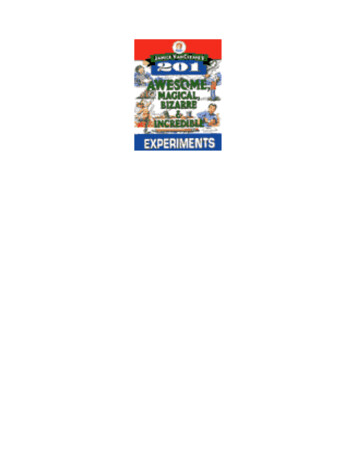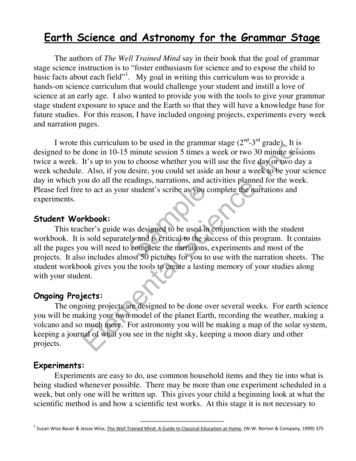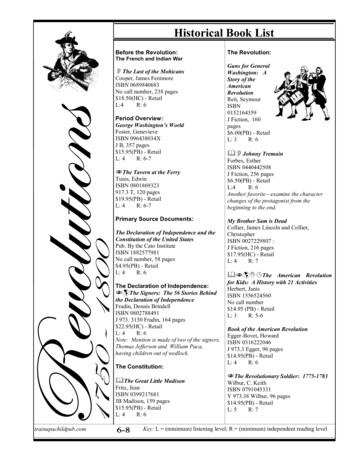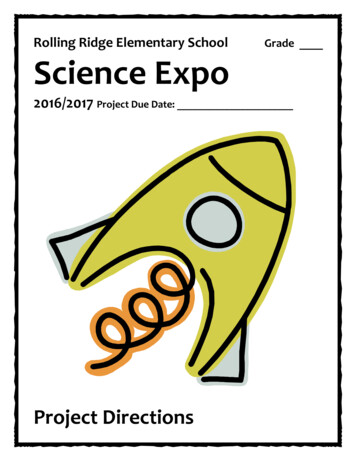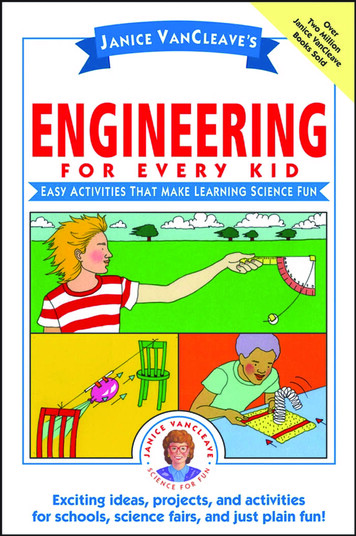
Transcription
ffirs.qxp1/31/0712:47 PMPage iiiJanice VanCleave’sEngineeringfor Every KidEasy Activities That MakeLearning Science FunJanice VanCleaveJohn Wiley & Sons, Inc.
ffirs.qxp1/31/0712:47 PMPage vi
ffirs.qxp1/31/0712:47 PMPage iJanice VanCleave’sEngineeringfor Every Kid
ffirs.qxp1/31/0712:47 PMPage iiOther Titles by Janice VanCleaveScience for Every Kid series:Janice VanCleave’s Astronomy for Every KidJanice VanCleave’s Biology for Every KidJanice VanCleave’s Chemistry for Every KidJanice VanCleave’s Constellations for Every KidJanice VanCleave’s Dinosaurs for Every KidJanice VanCleave’s Earth Science for Every KidJanice VanCleave’s Ecology for Every KidJanice VanCleave’s Energy for Every KidJanice VanCleave’s Food and Nutrition for Every KidJanice VanCleave’s Geography for Every KidJanice VanCleave’s Geometry for Every KidJanice VanCleave’s The Human Body for Every KidJanice VanCleave’s Math for Every KidJanice VanCleave’s Oceans for Every KidJanice VanCleave’s Physics for Every KidSpectacular Science Projects series:Janice VanCleave’s AnimalsJanice VanCleave’s EarthquakesJanice VanCleave’s ElectricityJanice VanCleave’s GravityJanice VanCleave’s Insects and SpidersJanice VanCleave’s MachinesJanice VanCleave’s MagnetsJanice VanCleave’s Microscopes and Magnifying LensesJanice VanCleave’s MoleculesJanice VanCleave’s PlantsJanice VanCleave’s Rocks and MineralsJanice VanCleave’s Solar SystemJanice VanCleave’s VolcanoesJanice VanCleave’s WeatherAlso:Janice VanCleave’s 200 Gooey, Slippery, Slimy, Weird, and Fun ExperimentsJanice VanCleave’s 201 Awesome, Magical, Bizarre, and Incredible ExperimentsJanice VanCleave’s 202 Oozing, Bubbling, Dripping, and Bouncing ExperimentsJanice VanCleave’s 203 Icy, Freezing, Frosty, and Cool ExperimentsJanice VanCleave’s 204 Sticky, Gloppy, Wacky, and Wonderful ExperimentsJanice VanCleave’s Great Science Project Ideas from Real KidsJanice VanCleave’s Guide to the Best Science Fair ProjectsJanice VanCleave’s Guide to More of the Best Science Fair ProjectsJanice VanCleave’s Science Around the YearJanice VanCleave’s Science Through the AgesJanice VanCleave’s ScientistsJanice VanCleave’s Science Around the World
ffirs.qxp1/31/0712:47 PMPage iiiJanice VanCleave’sEngineeringfor Every KidEasy Activities That MakeLearning Science FunJanice VanCleaveJohn Wiley & Sons, Inc.
ffirs.qxp1/31/0712:47 PMPage iv 2007 by Janice VanCleave. All rights reservedIllustrations other than those on pages 60–62 2007 by Laurie Hamilton. All rights reservedPublished by Jossey-BassA Wiley Imprint989 Market Street, San Francisco, CA 94103-1741www.josseybass.comWiley Bicentennial Logo: Richard J. PacificoNo part of this publication may be reproduced, stored in a retrieval system, or transmittedin any form or by any means, electronic, mechanical, photocopying, recording, scanning, orotherwise, except as permitted under Section 107 or 108 of the 1976 United States CopyrightAct, without either the prior written permission of the publisher, or authorization throughpayment of the appropriate per-copy fee to the Copyright Clearance Center, Inc., 222Rosewood Drive, Danvers, MA 01923, 978-750-8400, fax 978-646-8600, or on the Web atwww.copyright.com. Requests to the publisher for permission should be addressed to thePermissions Department, John Wiley & Sons, Inc., 111 River Street, Hoboken, NJ 07030, 201748-6011, fax 201-748-6008, or online at www.wiley.com/go/permissions.Limit of Liability/Disclaimer of Warranty: While the publisher and author have used theirbest efforts in preparing this book, they make no representations or warranties with respectto the accuracy or completeness of the contents of this book and specifically disclaim anyimplied warranties of merchantability or fitness for a particular purpose. No warranty maybe created or extended by sales representatives or written sales materials. The advice andstrategies contained herein may not be suitable for your situation. You should consult witha professional where appropriate. Neither the publisher nor author shall be liable for any lossof profit or any other commercial damages, including but not limited to special, incidental,consequential, or other damages.The publisher and the author have made every reasonable effort to insure that the experiments and activities in the book are safe when conducted as instructed but assume noresponsibility for any damage caused or sustained while performing the experiments or activities in this book. Parents, guardians, and/or teachers should supervise young readers whoundertake the experiments and activities in this book.Jossey-Bass books and products are available through most bookstores. To contact JosseyBass directly call our Customer Care Department within the U.S. at 800-956-7739, outside theU.S. at 317-572-3986, or fax 317-572-4002.Jossey-Bass also publishes its books in a variety of electronic formats. Some content thatappears in print may not be available in electronic books.Library of Congress Cataloging-in-Publication DataVanCleave, Janice Pratt.Janice VanCleave’s engineering for every kid : easy activities that make learning sciencefun / Janice VanCleave. — 1st ed.p. cm. — (Science for every kid)Includes index.ISBN 978-0-471-47182-0 (pbk.)1. Engineering—Experiments—Juvenile literature. 2. Science—Experiments—Juvenileliterature. I. Title. II. Series: VanCleave, Janice Pratt. Janice VanCleave science for every kidseries.TA149.V36 2006620.0078—dc222006010540Printed in the United States of Americafirst edition10 9 8 7 6 5 4 3 2 1
ffirs.qxp1/31/0712:47 PMPage vThis book is dedicated to a very loving ladyand a special person in my life:my daughter Ginger Russell.
ffirs.qxp1/31/0712:47 PMPage vi
ftoc.qxp1/31/0712:48 PMPage viiContentsIntroduction11.Push and PullStructural Engineering52.Blast OffAerospace Engineering113.Up and AwayAeronautical Engineering194.Up and DownRoller-Coaster Engineering275.Coming ThroughSolar Engineering356.Easy ListeningAcoustical Engineering437.Stop and GoElectrical Engineering518.DirectorsOptical Engineering599.RecoverPetroleum Engineering67Break OutNuclear Engineering7310.vii
ftoc.qxp1/31/07viii12:48 PMPage viiiContents11.New StuffChemical Engineering8112.Hot StuffFire Protection Engineering8713.BrighterProduct Development Engineering9514.PrimaryBiological Engineering10115.ShinyMetallurgical Engineering10716.The LimitStress Engineering11317.WeakenedProduct Durability Engineering11918.DiscardedEnvironmental Engineering12519.Less Is MoreGeotechnical Engineering13320.Flowing ThroughHydraulic Engineering13921.Shake UpEarthquake Engineering14522.ChangesMeteorological Engineering15123.Around and AroundHydrology Engineering159
ftoc.qxp1/31/0712:48 PMPage ixContentsix24.NeighborsAgricultural Engineering16525.StringyTextile Engineering171GlossaryIndex177197
ftoc.qxp1/31/0712:48 PMPage x
cintro.qxp1/31/0712:49 PMPage 1IntroductionThis is a basic book about engineering that is designed toteach facts, concepts, and problem-solving strategies. Eachsection introduces concepts about engineering that makelearning useful and fun.Engineering is the application of science, mathematics, andexperience to produce a thing or a process that is useful.Engineering is neither more nor less important than science,just different. The basic objective of science is to discover thecomposition and behavior of the physical world; that is, science is a study of the natural world. The basic objective ofengineering is to use scientific principles and methods toproduce useful devices and services that serve humankind.Examples of the work of engineers include making things likebuildings, bridges, and airplanes and designing useful services, such as ways to clean up an oil spill in the ocean or tokeep flood waters out of low-lying areas. Since useful thingsand processes must “obey” the laws of nature, engineersmust understand and use these laws. Although engineeringand science are two separate fields of study, in practice thework of real-world scientists and real-world engineers overlaps to some degree. For example, scientists use engineeringideas when they design instruments for experiments, andengineers use scientific experiments when they test the lawsof nature in order to develop new things.This book will not provide all the answers about engineering,but it will offer keys to understanding more about the work ofengineers. It will guide you to answering questions such as,1
cintro.qxp1/31/07212:49 PMPage 2Engineering for Every KidWhat wing shape gives airplanes their lift? How does knowledge about density help determine the best materials for firecontrol? What types of instruments do meteorological engineers design and test?This book is designed to teach engineering concepts so thatthey can be applied to many situations. The problems, experiments, and other activities are easy to understand. One of themain objectives of the book is to make learning about engineering fun.How to Use This BookRead each chapter slowly and follow procedures carefully.New terms are boldfaced and defined in the text when firstintroduced. So if you do not read the chapters in order, youmay need to look in the Glossary for unfamiliar science terms.The format for each section is: What You Need to Know: Background information andan explanation of terms. Exercises: Questions to be answered or situations to besolved using the information from What You Need toKnow. Activity: A project to allow you to apply the skill to a problem-solving situation in the real world. Solutions to Exercises: Step-by-step instructions forsolving the Exercises.All boldfaced terms are defined in the Glossary at the end ofthe book. Be sure to flip back to the Glossary as often as youneed to, making each term part of your personal vocabulary.
cintro.qxp1/31/0712:49 PMPage 3Introduction3General Instructions for the Exercises1. Study each problem and solution carefully by reading itthrough once or twice before answering.2. Check your answers in the Solutions to Exercises to evaluate your work.3. Do the work again if any of your answers are incorrect.General Instructions for the Activities1. Read each activity completely before starting.2. Collect needed supplies. You will have less frustrationand more fun if all the necessary materials for the activities are ready before you start. You lose your train ofthought when you have to stop and search for supplies.3. Do not rush through the activity. Follow each step verycarefully; never skip steps, and do not add your own.Safety is of utmost importance, and by reading each activity before starting, then following the instructions exactly,you can feel confident that no unexpected results willoccur.4. Observe. If your results are not the same as described inthe activity, carefully reread the instructions and startover from step 1.
cintro.qxp1/31/0712:49 PMPage 4
c01.qxp1/31/0712:50 PMPage 51Push and PullStructural EngineeringWhat You Need to KnowStructural engineering is the branch of engineering concerned with the design and construction of all types of structures such as bridges, buildings, dams, tunnels, power plants,offshore drilling platforms, and space satellites. Structuralengineers research the forces that will affect the structure,then develop a design that allows it to withstand these forces.A force is a push or a pull on an object. The two basic forceson a structure are lateral forces (forces directed at the sideof a structure) and vertical forces (forces directed up ordown on a structure). Lateral forces on a structure mightinclude wind (moving air).The main vertical force on a structure is gravity (force pullingan object downward, which is toward the center of Earth).Weight is the measure of the force of gravity on an object. Theweight of an object depends on mass, which is the amount ofsubstance in the object. The greater the mass, the greater theweight; thus, the greater the force of gravity.Engineers refer to the gravity force acting on a structure asthe sum of its dead and live forces. Dead forces are theweight of the permanent parts making up the structure. In abuilding, dead forces include the weight of the walls, floors,and roof. Live forces are the weight of temporary objects in5
c01.qxp1/31/07612:50 PMPage 6Engineering for Every Kidor on a structure. In a building, live forces include the weightof people, furniture, and snow on the roof. In the figure, liveforces include the weight of the wagon, the child, and the boy;dead forces include all the parts making up the bridge. Thetotal gravity force acting on the bridge is shown by the arrowdirected downward.Since shapes of materials affect their strength, structuralengineers must consider what shapes to use in designingstructures that will stand up to both lateral and vertical forces.Exercises1. In a building, which choice represents a live force?a. floorsb. windowsc. desk
c01.qxp1/31/0712:50 PMPage 7Push and Pull72. Which force in the figure, A, B, or C, is the lateralforce?Activity: SHAPELYPurpose To determine how the shape of a material canmake it stronger.Materials 2 books of equal thicknessruler1 sheet of copy paper15 or more pencilsProcedure1. Lay the books on a table so that they are 6 inches(15 cm) apart.
c01.qxp1/31/07812:50 PMPage 8Engineering for Every Kid2. Use the sheet of paper to make a bridge between the twobooks. Make sure that an equal amount of the paper lieson each book.3. Test the strength of the paper bridge by gently placingone pencil at a time in the center of the paper (betweenthe books) until the paper falls.4. Remove the paper from the books and fold it in half byplacing the short ends together. Fold the paper again inthe same direction.5. Unfold the paper, then bend it accordion style to form anM shape.6. Use the folded paper to form a bridge between the booksas shown. Again, make sure that an equal amount of thepaper is on each book.
c01.qxp1/31/0712:50 PMPage 9Push and Pull97. Test the strength of the paper bridge by gently placingone pencil at a time across the top of the folded paper. Ifthe pencil(s) tends to roll, use your finger to stop it.Count the pencils that the paper will support beforefalling.8. Remove the M-shaped bridge and press its sidestogether. Then fold the paper in half, placing the longsides together.9. Unfold the paper and bend it accordion style as before.The paper now has a double-M shape.10. Place the paper bridge across the books.11. Repeat step 7 with the double-M bridge.Results The unfolded paper will not support even one pencil.Depending on the weight of the pencils, the M-shaped bridgemay hold 4 to 6 pencils. The double-M bridge will hold morethan twice as many pencils as the single-M bridge.Why? A flat piece of paper is not very strong, but when it isfolded in an accordion shape, it becomes stronger and cansupport more weight. This is because all of the object’s weightpushes down on one part of the flat paper. But on the folded
c01.qxp1/31/071012:50 PMPage 10Engineering for Every Kidpaper, the object’s weight is spread out and smaller forcespush down on different parts of the paper. The more folds, themore spread out the weight. For example, corrugated cardboard, which has a layer of grooves and ridges, is muchstronger than flat cardboard.Solutions to Exercises1. Think! Floors are part of a structure, so they are permanentforces (dead forces). Windows are part of a structure, so they are permanent forces (dead forces). A desk is not part of a structure, since it can beremoved easily, so it is a temporary force—that is, alive force.Choice C is a live force.2. Think! A lateral force pushes or pulls on the side of astructure. Force A shows snow on the roof. Snow adds weightto the house, so it is a gravitational force. Force B shows a window in the house. Windows addweight to the house, so force B is a gravitationalforce. Force C shows wind hitting against the side of thehouse.Force C represents a lateral force.
c02.qxp1/31/0712:51 PMPage 112Blast OffAerospace EngineeringWhat You Need to KnowAerospace engineering is the branch of engineering concerned with the design, manufacture, and operation of launchvehicles, satellites, spacecraft, and ground-support facilitiesfor the exploration of outer space. One type of spacecraft isa rocket, which is powered by gases that are forced out ofone end. Rocket-like devices were demonstrated about 360B.C. by the Greek mathematician and scientist Archytas(428–350 B.C.). So while some form of a rocket has been inexistence for many years, the science of how a rocket workswas first described by the British scientist Sir Isaac Newton(1642–1727) in 1687. Newton stated three important scientificprinciples that govern the motion of all objects, whether onEarth or in space. These principles, now called Newton’s lawsof motion, provided engineers with the basic knowledge necessary to design modern rockets such as the Saturn V rockets and the Space Shuttle Discovery.Newton’s first law of motion is a law about inertia, whichis the tendency of an object at rest to remain at rest and anobject in motion to remain in motion. An unbalanced force isneeded to change the motion of an object; that is, the forcestarts or stops the motion of an object. When two or moreforces act on an object, if the forces are equal and in oppositedirections, the difference between the value of the forces is11
c02.qxp1/31/071212:51 PMPage 12Engineering for Every Kidzero; thus, they are balanced and there is no motion. But if theforces are not equal in value, the difference between theirvalue produces an unbalanced force (sum of unequal forcesacting on an object). For example, if two boys are pulling on theends of a rope in opposite directions and if one boy pulls withmore force to the left, the resulting unbalanced force makes therope and the boy holding the right end move to the left.Newton’s second law of motion explains how the forceneeded to accelerate (speed up) an object depends on themass of the object. It takes more force to accelerate a car thesame distance as a baseball because the car has a greatermass than the baseball. The same is true of deceleration,which means to slow down.Newton’s third law of motion explains that forces act inpairs. This law states that for every action there is an equaland opposite reaction. Newton realized that if one objectapplies a force on another, the second object applies an equalforce on the first object but in the opposite direction. Eachforce in an action-reaction pair of forces is equal and acts inthe opposite direction. But each force in the pair acts on a different object, so they are unbalanced forces. The action-reaction pairs in the diagram of the closed balloon are A1/B1 andA2/B2. You can be sure that two forces are action-reactionpairs if the objects in the description of one force can be interchanged to describe the other force. For example, “The gasinside the balloon pushes (force A) on the wall of the balloon.The wall of the balloon pushes (force B) on the gas inside.”In the figure of the open balloon, only one pair of the identified action-reaction forces is present: A1/B1. With the balloonopen, the force of the gas and the force of the balloon areunbalanced forces. So the gas does work (applies a force overa distance) on the balloon, causing it to move up. The workdone by the gas on the balloon is equal to the energy (abilityto do work) of the gas pushing on it. Energy of moving objects
c02.qxp1/31/0712:51 PMPage 13Blast Off13is called kinetic energy. Both work and energy equalsthe product of a force times the distance the force is applied.The energy and work of the gas on the balloon is equal to theenergy and work done by the balloon on the gas. This workcauses the gas to move down and out of the opening. With theballoon closed, neither the force of the gas nor the force of theballoon do work, meaning they don’t cause anything to move.This is because all the forces are balanced. Even so, the gasand the balloon have potential energy (stored energy).The same kinds of unbalanced forces make a rocket shipmove. The gas inside the rocket pushes up on the rocket, andthe rocket pushes the gas down and out. Aerospace engineersmust consider the best size and shape to use in designingrockets that will produce just the right unbalanced forces.
c02.qxp1/31/071412:51 PMPage 14Engineering for Every KidExercises1. Complete the description of the action-reaction pair offorces for the diagram.Force A: The gas pushes on the .Force B: The rocket pushes on the .LegendForcesDescriptionAGas inside rocket is acting on the rocketBRocket is acting on gas inside the rocket.
c02.qxp1/31/0712:51 PMPage 15Blast Off152. Which diagram of a rocket, A or B, shows balancedforces?Activity: UNBALANCEDPurpose To demonstrate the forces that propel a rocket.Materials 6 feet (1.8 m) of string4-inch (10-cm) piece of drinking straw2 chairs9-inch (23-cm) round balloonspring clothespintransparent tape
c02.qxp1/31/071612:51 PMPage 16Engineering for Every KidProcedure1. Thread the string through the straw.2. Tie the ends of the string to the backs of the chairs.3. Position the chairs so that the string between them is astight as possible.4. Inflate the balloon. Twist the open end of the balloon andsecure it with the clothespin.5. Move the straw to one end of the string.6. Tape the inflated balloon to the straw.7. Remove the clothespin from the balloon.Results The straw with the attached balloon quickly movesacross the string. The movement stops at the end of thestring or when the forces acting on the balloon are balanced.Why? When the inflated balloon is closed, the air insidepushes equally in all directions. The balloon doesn’t movebecause all the forces are balanced. When the balloon is
c02.qxp1/31/0712:51 PMPage 17Blast Off17open, the action-reaction pair of forces opposite the balloon’sopening is unbalanced. One force is the walls of the balloonpushing on the gas inside the balloon. This force pushes thegas out of the balloon’s opening. The other force is the gaspushing on the balloon’s wall opposite the opening. This forcepushes the balloon in the direction opposite the opening.Solutions to Exercises1. Think! Newton’s third law of motion states that for everyaction there is an equal and opposite reaction; thus,if one object applies a force on another, the secondobject applies the same force on the first object. Action-reaction pairs of forces do not act on thesame object. The objects in the description of one force in a pairof action-reaction forces can be interchanged todescribe the other force.Force A: The gas pushes on the rocket.Force B: The rocket pushes on the gas.2. Think! Forces A1 and A2 are equal in opposite directionsand act on the rocket. Forces B1 and B2 are equal in opposite directionsand act on the gas inside the rocket. Pairs of equal forces acting in opposite directions onthe same object are balanced forces.Figure A has two pairs of balanced forces.
c02.qxp1/31/0712:51 PMPage 18
c03.qxp1/31/0712:52 PMPage 193Up and AwayAeronautical EngineeringWhat You Need to KnowAeronautical engineering is the branch of engineering concerned with the design, construction, and operation of aircraft. These engineers must have an understanding ofaerodynamics, which is the study of the forces on an objectdue to the motion of the object through a fluid (gas or liquid)as well as the motion of the fluid on the object.Air is the gas mixture in the atmosphere (layer of gas surrounding Earth). Examples of the aerodynamics of air includethe study of the forces of wind (moving air) on a building andthe study of the forces of air on aircraft (vehicles that canmove through the air).There are four basic forces that affect the flight (action of anobject moving through the air) of an object through air: gravity, lift, thrust, and drag. The diagram shows how these forcesare related for a straight, level flight. Gravity is the verticaldownward force on an aircraft toward Earth’s surface. Weightis the measure of the force of gravity. The greater the mass ofthe aircraft, the greater its weight, thus the greater the force ofgravity on it. Lift is the vertical upward force on an aircraft.Weight and lift are forces in opposite directions. So for an aircraft to float in air, its lift force must be greater than its gravityforce. Thrust is the forward force on an aircraft, and drag is19
c03.qxp1/31/072012:52 PMPage 20Engineering for Every Kidthe force in a direction opposite of thrust. Drag is an exampleof friction, which is any force that resists the motion betweenobjects in contact with each other. For an aircraft to move forward, its thrust force must be greater than its drag force.An airplane has lift because of the way air flows around thewings. Lift occurs if air moving over the top of the wing isfaster than air moving over the bottom part of the wing. Thisis because as the speed of the air increases, the pressure itexerts on the surfaces it passes over decreases. This is knownas Bernoulli’s principle. So the slower-moving air under thewing applies more pressure on the wing than the faster-moving air flowing across the top of the wing. The lift under thewing has to be great enough to overcome the downwardforce of gravity as well as the downward force of air pressureon the top of the wing.There are two ways to produce a difference in airspeed aroundan aircraft wing. One way is for the wing to be an airfoil, whichis a surface designed to produce lift from air flowing around it.A curved upper surface of the wing creates less friction on theair flowing over it than does the flatter lower surface. Thecurved upper area makes the air above the wing travel a greaterdistance than the air beneath the wing. Because the air flowingover the top moves at a faster speed than air below the wing, the
c03.qxp1/31/0712:52 PMPage 21Up and Away21airstreams meet at the same time behind the wing. Lift occursbecause the slower-moving air below the wing pushes up morethan the faster-moving air above the wing pushes down.Another way to produce a difference in airspeed is to use a flatwing such as a kite and fly it at an angle to the wind. Air movesmore quickly over the top of the slanted wing, again creating lift.Exercises1. The figure shows the side view of an airplane wing.Using the words “higher” and “lower,” fill in the blanksbelow for each part described.a. Because the upper surface of the wing is morecurved than its underside, in comparison to the airspeed below the wing, the air moving over the tophas a airspeed.b. Because the lower surface of the wing is flatter thanthe upper surface, in comparison to the airspeedabove the wing, the air moving over the bottom ofthe wing has a airspeed.c. The difference between airspeed over the top andbottom of the wing creates an area of pressure above the wing and pressure below thewing.
c03.qxp1/31/072212:52 PMPage 22Engineering for Every Kid2. The difference between the air pressure above andbelow an airplane creates the force called .Activity: LIFTERPurpose To demonstrate the forces acting on a wing.Materials scissorsrulerfile folderpencilpaper hole punchtransparent tapelemon-sized piece of modeling clay12-inch (30-cm) wooden skewerhandheld hair dryeradult helperProcedure1. Cut a paper strip measuring 2-by-11-inches (5-by-27.5 cm)from the file folder.2. Draw three lines across the paper strip, at 1/2 inch (1.25cm), 4 inches (10 cm), and 7 inches (17.5 cm) from oneend. Label the lines A, B, and C.3. Using the paper hole punch, cut a hole in the center oflines B and C.
c03.qxp1/31/0712:52 PMPage 23Up and Away234. Bend the end closest to line C back so that the endtouches line A. Do not crease the bend. Secure theteardrop-shaped loop with a piece of tape.5. Place a grape-sized piece of clay on the pointed end of thewooded skewer. Stand the remaining clay on a table.6. Push the free, flat end of the wooden skewer through theholes in the paper and into the clay. Position the skewer sothat it stands vertically.7. With adult supervision, set the hair dryer on the cool setting at high speed. Hold the hair dryer about 6 inches (15cm) in front of the rounded side of the paper so that moreof the air flows over the upper part of the wing. Adjust theposition of the hair dryer so that the paper lifts.Results The paper lifts as air passes around the wing.Why? The paper wing is an example of an airfoil. Directingthe air so that more flows over the upper surface creates lowerpressure above the wing than below it. The air hitting thefront of the airfoil splits. The part of the air flowing over the
c03.qxp1/31/072412:52 PMPage 24Engineering for Every Kidmore curved upper surface has less friction, thus a fasterspeed and less pressure on the wing than the air flowing overthe less curved lower section of the wing. The differencebetween the air pressure creates lift on the wing, causing it torise on the wooden skewer.Solutions to Exercises1a. Think! The curved upper section has less friction than theair beneath the wing. This causes the air above thewing to move faster, creating a lower pressure thanthe air beneath the wing.In comparison to the airspeed below the wing, the air moving over the top of the wing has a high airspeed.1b. Think! The bottom of the wing is less curved than the top;thus, it has more friction. An increase in friction causes a decrease in speed.In comparison to the airspeed above the wing, the airmoving over the bottom of the wing has a low airspeed.1c. Think! According to Bernoulli’s principle, as the speed ofthe air increases over a surface, the air pressure onthat surface decreases. The speed of the air is greater above the wing thanbelow it. The speed of the air is less below the wing thanabove it.
c03.qxp1/31/0712:52 PMPage 25Up and Away25The difference betwee
Janice VanCleave's 202 Oozing, Bubbling, Dripping, and Bouncing Experiments Janice VanCleave's 203 Icy, Freezing, Frosty, and Cool Experiments Janice VanCleave's 204 Sticky, Gloppy, Wacky, and Wonderful Experiments Janice VanCleave's Great Science Project Ideas from Real Kids Janice VanCleave's Guide to the Best Science Fair Projects .
